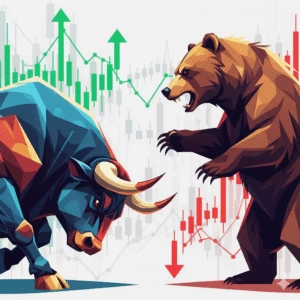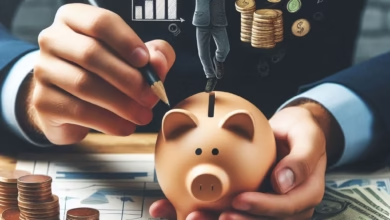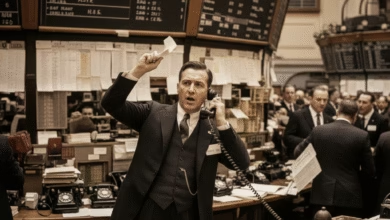5 interesting facts about the stock market that you didn’t know
Take a look at these interesting facts about the stock market and the financial market

The stock market is a constant presence in our lives. We hear about it on the news every night, we check its performance on our phones, and many of us rely on its growth for our retirement. It’s a world of complex charts, fast-moving tickers, and serious financial analysis. But behind this modern, high-tech facade lies a history filled with strange origins, quirky traditions, and truly incredible stories.
The market is more than just a mechanism for buying and selling shares; it’s a human institution that has evolved over centuries. Its story is filled with as much drama and intrigue as any blockbuster movie.
This article will pull back the curtain and reveal five fascinating facts about the stock market that will change the way you see it. From its chaotic beginnings under a tree to emergency brakes that can halt trillions of dollars in trading, these stories reveal the hidden history and surprising mechanics of the financial world.
1. The World’s First Stock Was for a Spice-Trading Mega-Corporation

When you think of the first publicly traded company, your mind might jump to railroads, early industrial giants, or perhaps a pioneering American bank. The reality is far more exotic and adventurous. The very first company to ever offer shares to the public was the Dutch East India Company (Verenigde Oostindische Compagnie, or VOC), all the way back in 1602.
The VOC was an enterprise of unprecedented scale and ambition. Granted a monopoly by the Dutch government, its mission was to dominate the incredibly lucrative—and dangerous—spice trade in Asia. A single voyage to the East Indies (modern-day Indonesia) was a monumental undertaking. It required enormous capital to build warships, hire crews, and stock provisions for a journey that could last for years, with no guarantee of return. The risk of storms, pirates, and disease was immense.
To fund these colossal ventures, the VOC did something revolutionary: instead of relying on a few wealthy backers, it sold shares of ownership to the general public. For the first time, ordinary citizens—from merchants and politicians to shopkeepers and artisans—could invest their savings to own a piece of the company. They shared in the potential for massive profits while limiting their personal risk to the value of their investment. This was the birth of the limited liability corporation and the world’s first IPO.
This innovation immediately created the need for a place where these new “shares” could be bought and sold. And so, the Amsterdam Stock Exchange was born, becoming the world’s first-ever formal stock exchange. It wasn’t tech stocks or government bonds being traded, but shares in a swashbuckling, globe-spanning corporation that had its own army and waged its own wars—all for the love of cinnamon and cloves.
2. The New York Stock Exchange Literally Started Under a Tree
The New York Stock Exchange (NYSE), the global symbol of financial power and American capitalism, has origins that are shockingly humble. It didn’t begin in a grand marble building or a formal boardroom. It started on a dirt path, in the shade of a buttonwood tree.
The year was 1792. New York City was just beginning its journey to becoming a financial hub. A small group of merchants and brokers were trading the first U.S. government bonds (issued to fund the Revolutionary War) and a handful of bank stocks. The trading was disorganized, often happening in coffee houses or at chaotic public auctions.
To bring order to this fledgling market, a group of 24 of the most prominent brokers decided to create a more formal arrangement. On May 17, 1792, they gathered on what is now Wall Street, under the protective branches of a large American sycamore, also known as a buttonwood tree. There, they signed a simple, two-sentence document that would change the course of financial history: the Buttonwood Agreement.
The agreement stipulated two key principles:
- The signers would only trade securities with each other, effectively creating an exclusive club that could control the market.
- They would charge a standardized commission rate of 0.25% on all transactions.
This simple pact brought structure and trust to the marketplace. It was the foundation of the NYSE’s members-only model that would last for over two centuries. The exchange eventually moved indoors to the Tontine Coffee House and later to its iconic building at 11 Wall Street, but its roots will forever be tied to that informal meeting under a tree, a powerful reminder of how the world’s most powerful institutions can grow from the simplest of beginnings.
3. The Entire Stock Market Has an Emergency Brake
What happens when the stock market goes into a freefall? In an age of high-speed algorithmic trading, a wave of panic-selling could spiral out of control in minutes, causing a catastrophic crash. To prevent this, the entire U.S. stock market is equipped with a set of “emergency brakes” known as market-wide circuit breakers.
Think of them as a mandatory timeout during a chaotic game. If the S&P 500 index—the benchmark for the overall market—drops by a certain percentage from its previous day’s close, these circuit breakers automatically halt all trading across every U.S. stock exchange.
There are three levels of circuit breakers:
- Level 1: A 7% drop before 3:25 p.m. ET triggers a 15-minute trading halt.
- Level 2: A 13% drop before 3:25 p.m. ET triggers another 15-minute trading halt.
- Level 3: A 20% drop at any time during the day will shut down the market for the remainder of the day.
This system was first implemented after the infamous “Black Monday” crash on October 19, 1987, when the Dow Jones Industrial Average plunged nearly 23% in a single day. Regulators realized they needed a mechanism to interrupt the panic, force traders to take a breath, and allow cooler heads to prevail.
While rarely used, the circuit breakers have been triggered in modern times, most notably during the intense market volatility at the onset of the COVID-19 pandemic in March 2020, when they were tripped four times in the span of just two weeks. They are a powerful and invisible safety net designed to protect the market from its own worst instincts.
4. The “Bull” and “Bear” Have Mysterious, centuries-old Origins

Every investor knows the two spirit animals of the market: the bull, representing a rising market, and the bear, representing a falling one. A “bull market” is a period of optimism and rising prices, while a “bear market” is a period of pessimism and steep declines (technically, a drop of 20% or more from recent highs). But where did these iconic terms come from?
The truth is, no one knows for certain, but the most popular theories are fascinating glimpses into history.
The most common explanation relates to the animals’ method of attack. A bull thrusts its horns upward into the air, mirroring a rising market. A bear, conversely, swipes its powerful paws downward, symbolizing a market in decline. This simple, visual metaphor is easy to understand and has stuck for centuries.
However, a more compelling historical theory traces the “bear” back to 18th-century England and a grim proverb: “to sell the bearskin before one has caught the bear.” This phrase referred to middlemen, known as “bearskin jobbers,” who would sell the skins of bears they had not yet hunted and killed. In the financial world, this term was applied to speculators who engaged in an early form of short selling—selling a stock they didn’t yet own, hoping to buy it back later at a lower price. These “bearskin jobbers” were betting on a price drop, and the name “bear” became shorthand for a pessimistic, downward-trending market. The “bull” likely arose as its natural, powerful opposite.
5. The Original Dow Jones Index Had 12 Stocks—And None of Them Remain
The Dow Jones Industrial Average (DJIA) is arguably the most famous stock market index in the world. When a news anchor says “the market is up today,” they are most often referring to the Dow. But this modern barometer of 30 massive blue-chip companies looked very different at its inception.
Created in 1896 by Charles Dow and Edward Jones, the original DJIA was designed to be a simple average of the stock prices of the most important industrial companies of the era. This first-ever index was composed of just 12 stocks.
Looking at the list is like opening a time capsule of the 19th-century American economy. It included companies like:
- American Cotton Oil Company
- American Sugar Company
- Chicago Gas Company
- Tennessee Coal, Iron and Railroad Company
- U.S. Leather Company (a preferred stock)
These were the industrial titans of their day, dominating industries from sugar refining and gas lighting to leather tanning and coal mining. Yet, in a powerful testament to the relentless evolution of the economy, not a single one of these original 12 companies remains in the Dow Jones Industrial Average today.

Over the decades, companies have been removed due to mergers, bankruptcy, or simply becoming less relevant to the U.S. economy, replaced by new leaders in technology, healthcare, and finance. The last of the original members, General Electric, was removed in 2018. The DJIA is not just an index; it’s a living document of creative destruction and the dynamic, ever-changing nature of American industry.





